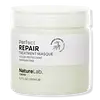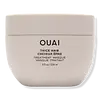What's inside
What's inside
 Key Ingredients
Key Ingredients

 Benefits
Benefits

 Concerns
Concerns

 Ingredients Side-by-side
Ingredients Side-by-side

Water
Skin ConditioningCetearyl Alcohol
EmollientDimethicone
EmollientSteartrimonium Chloride
PreservativeGlucose
HumectantPhyllostachys Pubescens Meristem Cell Lysate
Skin ConditioningArgania Spinosa Sprout Cell Extract
Skin ConditioningMalus Domestica Fruit Cell Culture Extract
Skin ConditioningVitis Vinifera Fruit Cell Extract
Skin ConditioningGlutamic Acid
HumectantSodium PCA
HumectantKeratin
Skin ConditioningHydrolyzed Keratin
HumectantPrunus Domestica Seed Extract
EmollientArgania Spinosa Kernel Oil
EmollientLupinus Albus Seed Oil
Skin ConditioningMangifera Indica Seed Oil
EmollientTheobroma Grandiflorum Seed Butter
Skin ConditioningAdansonia Digitata Seed Oil
EmollientCarapa Guaianensis Seed Oil
Skin ConditioningSclerocarya Birrea Seed Oil
HumectantOpuntia Ficus-Indica Seed Oil
EmollientIsomalt
HumectantEthylhexyl Palmitate
EmollientDipentaerythrityl Tri-Polyhydroxystearate
EmollientDimethiconol
EmollientHydrogenated Castor Oil Isostearate
Skin ConditioningDipentaerythrityl Hexahydroxystearate/Hexastearate/Hexarosinate
Skin ConditioningHydroxyethylcellulose
Emulsion StabilisingXanthan Gum
EmulsifyingLecithin
EmollientDicocodimonium Chloride
EmulsifyingCetrimonium Chloride
AntimicrobialBenzotriazolyl Dodecyl P-Cresol
UV AbsorberIsopropyl Alcohol
SolventGlycerin
HumectantTocopherol
AntioxidantEtidronic Acid
Phenoxyethanol
PreservativeSodium Benzoate
MaskingParfum
MaskingCI 19140
Cosmetic ColorantCI 42090
Cosmetic ColorantCI 17200
Cosmetic ColorantWater, Cetearyl Alcohol, Dimethicone, Steartrimonium Chloride, Glucose, Phyllostachys Pubescens Meristem Cell Lysate, Argania Spinosa Sprout Cell Extract, Malus Domestica Fruit Cell Culture Extract, Vitis Vinifera Fruit Cell Extract, Glutamic Acid, Sodium PCA, Keratin, Hydrolyzed Keratin, Prunus Domestica Seed Extract, Argania Spinosa Kernel Oil, Lupinus Albus Seed Oil, Mangifera Indica Seed Oil, Theobroma Grandiflorum Seed Butter, Adansonia Digitata Seed Oil, Carapa Guaianensis Seed Oil, Sclerocarya Birrea Seed Oil, Opuntia Ficus-Indica Seed Oil, Isomalt, Ethylhexyl Palmitate, Dipentaerythrityl Tri-Polyhydroxystearate, Dimethiconol, Hydrogenated Castor Oil Isostearate, Dipentaerythrityl Hexahydroxystearate/Hexastearate/Hexarosinate, Hydroxyethylcellulose, Xanthan Gum, Lecithin, Dicocodimonium Chloride, Cetrimonium Chloride, Benzotriazolyl Dodecyl P-Cresol, Isopropyl Alcohol, Glycerin, Tocopherol, Etidronic Acid, Phenoxyethanol, Sodium Benzoate, Parfum, CI 19140, CI 42090, CI 17200
Water
Skin ConditioningCetyl Alcohol
EmollientBehentrimonium Chloride
PreservativeCetearyl Alcohol
EmollientButyrospermum Parkii Butter
Skin ConditioningAmodimethicone
Behentrimonium Methosulfate
Hydrogenated Castor Oil/Sebacic Acid Copolymer
EmollientStearamidopropyl Dimethylamine
EmulsifyingCetyl Esters
EmollientQuaternium-87
CleansingC18-38 Alkyl Hydroxystearoyl Stearate
EmollientOlea Europaea Fruit Oil
MaskingPropylene Glycol Dibenzoate
Skin ConditioningPrunus Amygdalus Dulcis Oil
Skin ConditioningMacadamia Ternifolia Seed Oil
EmollientKeratin
Skin ConditioningHydrolyzed Keratin
HumectantHydrolyzed Pea Protein
EmollientHydrolyzed Adansonia Digitata Seed Extract
Shorea Stenoptera Seed Butter
EmollientTocopherol
AntioxidantC10-40 Isoalkylamidopropylethyldimonium Ethosulfate
Ascorbyl Palmitate
AntioxidantCaprylyl Glycol
EmollientBHT
AntioxidantTrideceth-3
EmulsifyingTrideceth-15
EmulsifyingAcetic Acid
BufferingDimethicone
EmollientLaureth-23
CleansingLaureth-4
EmulsifyingSalicylic Acid
MaskingDivinyldimethicone/Dimethicone Copolymer
C12-13 Pareth-23
CleansingC12-13 Pareth-3
EmulsifyingSodium Hydroxide
BufferingHydroxyethylcellulose
Emulsion StabilisingDisodium Phosphate
BufferingSodium Phosphate
BufferingPolysorbate 60
EmulsifyingGuar Hydroxypropyltrimonium Chloride
Skin ConditioningCitric Acid
BufferingDisodium EDTA
Cetrimonium Chloride
AntimicrobialSodium Chloride
MaskingIsopropyl Alcohol
SolventPotassium Sorbate
PreservativeBenzyl Alcohol
PerfumingSodium Benzoate
MaskingPhenoxyethanol
PreservativeParfum
MaskingLinalool
PerfumingCitronellol
PerfumingWater, Cetyl Alcohol, Behentrimonium Chloride, Cetearyl Alcohol, Butyrospermum Parkii Butter, Amodimethicone, Behentrimonium Methosulfate, Hydrogenated Castor Oil/Sebacic Acid Copolymer, Stearamidopropyl Dimethylamine, Cetyl Esters, Quaternium-87, C18-38 Alkyl Hydroxystearoyl Stearate, Olea Europaea Fruit Oil, Propylene Glycol Dibenzoate, Prunus Amygdalus Dulcis Oil, Macadamia Ternifolia Seed Oil, Keratin, Hydrolyzed Keratin, Hydrolyzed Pea Protein, Hydrolyzed Adansonia Digitata Seed Extract, Shorea Stenoptera Seed Butter, Tocopherol, C10-40 Isoalkylamidopropylethyldimonium Ethosulfate, Ascorbyl Palmitate, Caprylyl Glycol, BHT, Trideceth-3, Trideceth-15, Acetic Acid, Dimethicone, Laureth-23, Laureth-4, Salicylic Acid, Divinyldimethicone/Dimethicone Copolymer, C12-13 Pareth-23, C12-13 Pareth-3, Sodium Hydroxide, Hydroxyethylcellulose, Disodium Phosphate, Sodium Phosphate, Polysorbate 60, Guar Hydroxypropyltrimonium Chloride, Citric Acid, Disodium EDTA, Cetrimonium Chloride, Sodium Chloride, Isopropyl Alcohol, Potassium Sorbate, Benzyl Alcohol, Sodium Benzoate, Phenoxyethanol, Parfum, Linalool, Citronellol
 Reviews
Reviews

Ingredients Explained
These ingredients are found in both products.
Ingredients higher up in an ingredient list are typically present in a larger amount.
Cetearyl alcohol is a mixture of two fatty alcohols: cetyl alcohol and stearyl alcohol. It is mainly used as an emulsifier. Emulsifiers help prevent the separation of oils and products. Due to its composition, it can also be used to thicken a product or help create foam.
Cetearyl alcohol is an emollient. Emollients help soothe and hydrate the skin by trapping moisture.
Studies show Cetearyl alcohol is non-toxic and non-irritating. The FDA allows products labeled "alcohol-free" to have fatty alcohols.
This ingredient is usually derived from plant oils such as palm, vegetable, or coconut oils. There is debate on whether this ingredient will cause acne.
Due to the fatty acid base, this ingredient may not be Malassezia folliculitis safe.
Learn more about Cetearyl AlcoholThis ingredient is a preservative, antimicrobial, and emulsifier. It is often used in cosmetics for its ability to cleanse, condition, and reduce static.
Cetrimonium chloride is a quaternary ammonium salt, meaning it has a water-soluble structure.
Dimethicone is a type of synthetic silicone created from natural materials such as quartz.
What it does:
Dimethicone comes in different viscosities:
Depending on the viscosity, dimethicone has different properties.
Ingredients lists don't always show which type is used, so we recommend reaching out to the brand if you have questions about the viscosity.
This ingredient is unlikely to cause irritation because it does not get absorbed into skin. However, people with silicone allergies should be careful about using this ingredient.
Note: Dimethicone may contribute to pilling. This is because it is not oil or water soluble, so pilling may occur when layered with products. When mixed with heavy oils in a formula, the outcome is also quite greasy.
Learn more about DimethiconeHydrolyzed Keratin is derived from keratin. Keratin is a large protein that is naturally found in our hair and skin.
Studies show keratin is able to seal broken hair cuticles, helping to prevent split ends and breakage.
As a humectant, hydrolyzed keratin helps draw moisture from the air to your hair and skin. This helps keep your skin and hair hydrated.
Learn more about Hydrolyzed KeratinHydroxyethylcellulose is used to improve the texture of products. It is created from a chemical reaction involving ethylene oxide and alkali-cellulose. Cellulose is a sugar found in plant cell walls and help give plants structure.
This ingredient helps stabilize products by preventing ingredients from separating. It can also help thicken the texture of a product.
This ingredient can also be found in pill medicines to help our bodies digest other ingredients.
Learn more about HydroxyethylcelluloseIsopropyl Alcohol is more commonly known as rubbing alcohol. It is most commonly used as a solvent, meaning it helps other ingredients dissolve.
This ingredient is an astringent alcohol. Astringent alcohols may also irritate skin as they high amounts may strip away your skin's natural oils.
Other types of astringent alcohols include:
According to the National Rosacea Society based in the US, you should be mindful of products with these alcohols in the top half of ingredients.
Any type of sanitizing product will have high amounts of alcohol to help kill bacteria and viruses.
Learn more about Isopropyl AlcoholKeratin is a protein naturally found in our hair and skin.
In haircare, it has been shown to seal broken cuticles. This can help prevent breakage and split ends.
Parfum is a catch-all term for an ingredient or more that is used to give a scent to products.
Also called "fragrance", this ingredient can be a blend of hundreds of chemicals or plant oils. This means every product with "fragrance" or "parfum" in the ingredients list is a different mixture.
For instance, Habanolide is a proprietary trade name for a specific aroma chemical. When used as a fragrance ingredient in cosmetics, most aroma chemicals fall under the broad labeling category of “FRAGRANCE” or “PARFUM” according to EU and US regulations.
The term 'parfum' or 'fragrance' is not regulated in many countries. In many cases, it is up to the brand to define this term.
For instance, many brands choose to label themselves as "fragrance-free" because they are not using synthetic fragrances. However, their products may still contain ingredients such as essential oils that are considered a fragrance by INCI standards.
One example is Calendula flower extract. Calendula is an essential oil that still imparts a scent or 'fragrance'.
Depending on the blend, the ingredients in the mixture can cause allergies and sensitivities on the skin. Some ingredients that are known EU allergens include linalool and citronellol.
Parfum can also be used to mask or cover an unpleasant scent.
The bottom line is: not all fragrances/parfum/ingredients are created equally. If you are worried about fragrances, we recommend taking a closer look at an ingredient. And of course, we always recommend speaking with a professional.
Learn more about ParfumPhenoxyethanol is a preservative that has germicide, antimicrobial, and aromatic properties. Studies show that phenoxyethanol can prevent microbial growth. By itself, it has a scent that is similar to that of a rose.
It's often used in formulations along with Caprylyl Glycol to preserve the shelf life of products.
Sodium Benzoate is a preservative. It's used in both cosmetic and food products to inhibit the growth of mold and bacteria. It is typically produced synthetically.
Both the US FDA and EU Health Committee have approved the use of sodium benzoate. In the US, levels of 0.1% (of the total product) are allowed.
Sodium benzoate works as a preservative by inhibiting the growth of bacteria inside of cells. It prevents the cell from fermenting a type of sugar using an enzyme called phosphofructokinase.
It is the salt of benzoic acid. Foods containing sodium benzoate include soda, salad dressings, condiments, fruit juices, wines, and snack foods.
Studies for using ascorbic acid and sodium benzoate in cosmetics are lacking, especially in skincare routines with multiple steps.
We always recommend speaking with a professional, such as a dermatologist, if you have any concerns.
Learn more about Sodium BenzoateTocopherol (also known as Vitamin E) is a common antioxidant used to help protect the skin from free-radicals and strengthen the skin barrier. It's also fat soluble - this means our skin is great at absorbing it.
Vitamin E also helps keep your natural skin lipids healthy. Your lipid skin barrier naturally consists of lipids, ceramides, and fatty acids. Vitamin E offers extra protection for your skin’s lipid barrier, keeping your skin healthy and nourished.
Another benefit is a bit of UV protection. Vitamin E helps reduce the damage caused by UVB rays. (It should not replace your sunscreen). Combining it with Vitamin C can decrease sunburned cells and hyperpigmentation after UV exposure.
You might have noticed Vitamin E + C often paired together. This is because it is great at stabilizing Vitamin C. Using the two together helps increase the effectiveness of both ingredients.
There are often claims that Vitamin E can reduce/prevent scarring, but these claims haven't been confirmed by scientific research.
Learn more about TocopherolWater. It's the most common cosmetic ingredient of all. You'll usually see it at the top of ingredient lists, meaning that it makes up the largest part of the product.
So why is it so popular? Water most often acts as a solvent - this means that it helps dissolve other ingredients into the formulation.
You'll also recognize water as that liquid we all need to stay alive. If you see this, drink a glass of water. Stay hydrated!
Learn more about Water